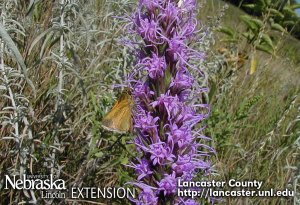
Soldier beetle in a field bindweed flower
Field Bindweed: described as “a spreading perennial difficult to control because of its above ground runners that can spread many feet from the mother plant, as well as an extensive below ground rhizome system. Hand-pulling is good exercise but probably not effective for control.”
Personally, I’ve always had negative experiences involving field bindweed. Growing up, “we kids” were assigned the duty of trying to pull the tough, persistent weed out of the vegetable and flower gardens. It was a never-ending job and the plant seemed to enjoy watching us suffer year after year. Today, I found revenge – an article on bindweed control. I know… I smiled. “Field bindweed aggressively spreading right now, but control is easy“. Great news! Control is finally easy! I still hesitate to call any control of bindweed “easy” but decided it was something visitors to our office Web site would be interested in. Needing a photo to go with the feature, I headed straight out my door to my perennial bed. No problem finding field bindweed. It has followed me wherever I’ve tried to garden and I still try to hand pull it, without success.
Feeling like the end of my battle with the weed may soon be over, I centered my camera over one of the morning glory-like flowers on the field bindweed. Now, here’s why I’m even posting any of this on a pollinator habitat page. Looking through my camera lens, I see a soldier beetle busy serving its role as a pollinator by taking in nectar from the bindweed flower. When we think of plants for pollinators, we sometimes forget that even plants we “humans” don’t want, can be important to insects and wildlife. I paused, stood up and took another look at my landscape. The “invasive weeds” in my beds were buzzing with activity – honeybees on the creeping bellflower and tiny insects on the wild four o’clock. I’ve been so busy adding “pretty” plants for pollinators, I’ve forgotten to look at what I already have like white clover and my Linden tree (blooming now).
So what will I do? Oh, I’ll continue to manually control invasive plants like the bindweed and bellflower – they have the upper hand anyway so there will always be a few for the local pollinator population. And, I’ll try to bump up my tolerance a bit and see some of these plants as “beautiful” in my garden. It is also an important reminder to use caution when considering any pesticides because beneficial wildlife can be everywhere and that’s a very good thing!
Here’s to Sharing the Buzz!
Soni
UNL Extension provides research-based information to help you make informed decisions any time, any place, anywhere – http://lancaster.unl.edu
40.820335
-96.725306



